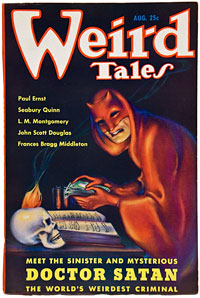 The practice of calling pulps devoted to, and often named after, the hero contained in them “hero pulps” is well understood. But some argue they should be called “character pulps,” because some of them had the villain as the star.
The practice of calling pulps devoted to, and often named after, the hero contained in them “hero pulps” is well understood. But some argue they should be called “character pulps,” because some of them had the villain as the star.
What? The villain is the main focus?
Yes. And actually this has been a long running, though lesser known literary phenomenon. There have been several fiction works (stories and novels, movies and movie series, and TV shows) where the villain is the main star.
In literature you have Dr. Nikola (1895-1901); in French pulps and movies you had Fantomas (1911-63); Belphegor (1927); Les Vampires (1915); The Black Coats (1843-75); and others. Probably the most well known of villainous characters is Dr. Fu Manchu (1913-59). Among European comics, you have several that star the villain, such as Diabolik, Satanik, Killing, etc.
And so, there were attempts at having the villain be the main star of certain pulp series. Sadly, however, most were short-lived. There are probably reasons, the main being probably the difficulty to sustain a monthly (or bimonthly) series with the villain always getting away at the end. Other long-running series like Fu Manchu or Fantomas weren’t published so frequently.
Another problem was having a good hero to stand up to the villain; one that the villain could regularly elude, which makes the hero look weak. But publishers tried.
Known villain pulps:
- Doctor Death, 1934 & 1935
- Doctor Satan, 1935-36
- Wu Fang, 1935-36
- Dr. Yen Sin, 1936
- The Octopus/The Scorpion, 1939
Doctor Death
Now, what is confusing about Doctor Death is that there are two Doctor Deaths! Some have tried to claim they are the same character, but I don’t buy it.
Doctor Death first appeared in short stories by Edward Norris. He was a villain in stories starring Nibs Holloway, a troubelshooter for a jewelry company. Doctor Death in these stories is an unknown international criminal. He was introduced in the second Nibs story, and killed off at the end. For some reason (probably reader interest), he was brought back in the fourth Nibs story, and again killed off. He would appear in the next two Nibs stories, again apparently killed off at the end of each story, to somehow return. These stories all appeared in Dell’s All-Detective Magazine.
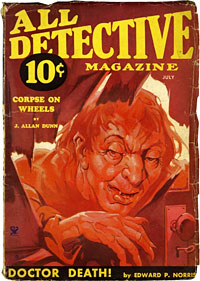 For those wanting to read these Doctor Death stories, Altus Press put out a collection of them. They wanted to include the other Nibs stories, but couldn’t find them.
For those wanting to read these Doctor Death stories, Altus Press put out a collection of them. They wanted to include the other Nibs stories, but couldn’t find them.
Obviously, the character was more interesting then the hero, so I guess Dell decided to make the villain the star of the series, and have Harold Ward write the new Doctor Death novels, pitting him against a different hero.
Considering that Nibs was just a troubleshooter for a jewelry company, it made it difficult to come up with scenarios in which he would be pitted against a super villain like Doctor Death.
So the second Doctor Death appeared in 1935, now in his own magazine. It was a re-titling of All-Detectives Magazine, and just before the re-title was where the prior Doctor Death appeared! Altus Press has reprinted these new Doctor Death stories in two volumes of “Doctor Death Vs. The Secret Twelve.”
Doctor Death ran three issues and was canceled. The stories from those issues — “Twelve Must Die,” “The Gray Creatures,” and “The Shriveling Murders” — are reprinted in the first volume. Two more stories — “Waves of Madness” and “The Red Mist of Death” — were written, but not published, and those are reprinted in the second volume. All stories were published under the house name of “Zorro.”
Doctor Death was really a crazed scientist named Dr. Rance Mandarin. He felt the Earth was over populated, and so to deal with that, went after the human race with a variety of evil means, both scientific and occult. He basically wanted to reduce the population and return us to the stone age. He was opposed by Jimmy Holm, a millionaire and criminologist, backed by a secret group of 12 that included the U.S. President. There was also beautiful Nina Ferrera, the Doctor’s lovely assistant, who would fall in love with Jimmy and become engaged to him. A later addition was the evil, resurrected Egyptian princess Charmion, who would become a possible (if you can believe it) love interest and ally of Dr. Death.
As a bonus, Altus Press worked with the Ward estate to add some special items, including information on a planned Doctor Death comic strip. You can read a script that adapts the first story over multiple weeks in a comic strip.
The cover of the first issue is used as the cover of the first volume; the second issue cover is used as the cover of the second volume. All three covers are shown on the back of the first volume. In addition, the original interior art from the three published issues is included, a great bonus.
Doctor Satan
Most pulp fans know Weird Tales magazine as the long-running occult/horror/fantasy pulp that published such greats as H.P. Lovecraft, Seabury Quinn, and many others. While it did have some continuing characters like Quinn’s Julies de Grandin and Manly Wade Wellman‘s characters, its only foray into the world of “hero pulps” (or in this case “villain pulps”) was their short-lived series staring villain Doctor Satan, written by pulp scribe Paul Ernst (better known for The Avenger), who would be featured on the cover.
Running eight stories, these pitted the evil Doctor Satan against Ascott Keane, an occult detective. Doctor Satan wore a red cloak with a red mask with horns on it. We never learn who (or what) he is. Doctor Satan was assisted by the dwarf Girse and the legless giant Bostiff.
Doctor Satan has since fallen into the pulp domain, and he has been used as a character in several New Pulp works. In particular, Barry Reese has used Doctor Satan (and Ascott Keane) many times in his Rook series.
For those wanting to read the originals, Altus Press is finally putting out a reprint of them, “The Complete Tales of Doctor Satan.”
Wu Fang
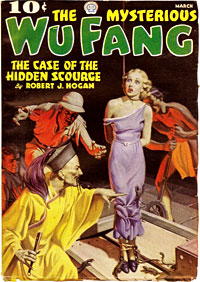 Popular Publications tried getting into the villain pulp line with the “Yellow Peril” character Wu Fang, authored by Robert Hogan, creator of G-8. It only lasted seven issues (an eighth was announced, but no idea if it was written). Apparently when the Sax Rohmer estate complained the name was too similar to Fu Manchu, it was shutdown. Wu Fang was opposed by Val Kildare, a Federal agent. And yes, there was a girl involved: Mohara, an assistant to Wu Fang who falls in love with Val. (Sound familiar?)
Popular Publications tried getting into the villain pulp line with the “Yellow Peril” character Wu Fang, authored by Robert Hogan, creator of G-8. It only lasted seven issues (an eighth was announced, but no idea if it was written). Apparently when the Sax Rohmer estate complained the name was too similar to Fu Manchu, it was shutdown. Wu Fang was opposed by Val Kildare, a Federal agent. And yes, there was a girl involved: Mohara, an assistant to Wu Fang who falls in love with Val. (Sound familiar?)
Sadly, a complete reprint has yet to appear. Bob Weinberg reprinted the first story in Pulp Classics #8, then the next five were reprinted in High Adventure. I keep hoping Altus Press (or someone) would do a complete reprint of the series.
Dr. Yen Sin
With the demise of Wu Fang, Popular tried again, this time with the shorter-lived pulp Dr. Yen Sin, authored by Donald Keyhoe, who also wrote pulp heroes Phillip Strange, Richard Knight and others. Another “Yellow Peril” villain, he is opposed by Michael Traile, who due to a childhood injury cannot sleep. He needs to meditate to gain the same benefits. The girl this time is Sonia Damitri.
Lasting only three issues, there is also no collected reprint. Weinburg reprinted the first story in Pulp Classics #9, with the other two reprinted in High Adventure.
The Octopus/The Scorpion
And finally, Popular put out single issues of what has to be the most bizarre pair of villain pulps: The Octopus and The Scorpion. These two villains are linked (most feel The Scorpion was a revamp/rewrite of the second Octopus story) by being opposed by the same hero: the Skull Killer, one of the most bizarre pulp heroes ever.
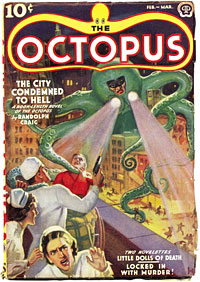 The Skull Killer was Jeffrey Fairchild. The son of a well-known physician, Fairchild also attended medical school, but never practiced medicine under his own name. Instead, Fairchild adopts two identities. One is kindly old Dr. Skull, who treats those living in the slums. And the other is the Skull Killer, scourge of the underworld, who has killed at least 30 men (all bad) in the last six years. He marks his victims with a skull burned into their forehead (sound familiar?).
The Skull Killer was Jeffrey Fairchild. The son of a well-known physician, Fairchild also attended medical school, but never practiced medicine under his own name. Instead, Fairchild adopts two identities. One is kindly old Dr. Skull, who treats those living in the slums. And the other is the Skull Killer, scourge of the underworld, who has killed at least 30 men (all bad) in the last six years. He marks his victims with a skull burned into their forehead (sound familiar?).
Also confusing is the authorship of the Octopus and Scorpion stories (both appearing under the house name Randolph Craig). The Octopus is believed to have been written by the Ejler and Edith Jacobsen with The Spider author Norvell Page revamping it. The Scorpion is believed to have been written by just Page.
Weinburg reprinted each story in Pulp Classics #11 and #12. More recently Baen Books reprinted The Octopus with a couple of Page’s Spider novels, but didn’t include The Scorpion in their next Spider collection. I keep hoping Altus Press would reprint the two together, maybe in the style of the old Ace Double Novels.
So, there you have them: the villain pulps. Check them out.
UPDATE: Since this was posted, Altus Press/Steeger Books has reprinted all the Wu Fang and Dr. Yen Sin stories in stand along volumes. No idea when we’ll see a modern reprint of the Octopus/Scorpion stories.

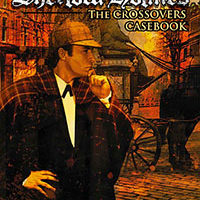

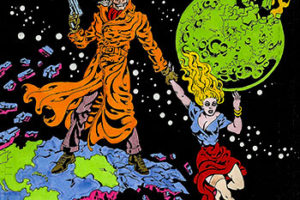
Girasol Collectibles has reprinted all issues of Wu Fang and Dr. Yen-Sin, along with The Octopus and The Scorpion one-shots, at $35 each. You can get more information at http://www.girasolcollectables.com.
Yes, am aware of pulp facsimiles from Girasol and others, but they are just too pricey for me. For the cost of ONE facsimile (with one novel), I can get a complete collection of 3-5 novels from Altus Press.
Girasol did replicas of the three DR. DEATH pulps also. Additionally, Corinth paperbacks back in the early 1960s did editions of the three DOCTOR DEATH novels from those pulps, plus a fourth volume collecting some of the short stories that filled out the issue. (Corinth of course did a lot of other pulp hero reprints as well, but they didn’t get involved with the other villain pulps). Odyssey Press (if I recall correctly) also did reprints of the OCTOPUS and SCORPION lead novels, and R.A.W.Lowndes’ much-missed STARTLING MYSTERY STORIES reprinted several of the Dr. Satan novelettes.
Am quite aware of the pulp facsimiles from Girasol and others. I do not promote them because they are expensive. For the price of 1 facsimile, one could get a pulp reprint with 3-4 novels.
Am also aware of the Corinth reprints and own a few. I didn’t mention them because they are pricey and hard to find, especially as the Altus Press is easy to obtain and reasonably priced.
I do plan to do an article on the history of the paperback reprints of pulp heroes. Not sure when this will be completed, but at least a summary will be posted.